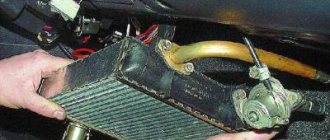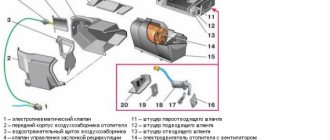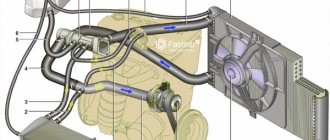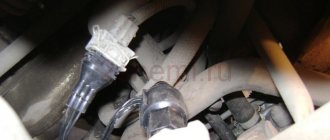Why is additional heating needed?
When storing a car in open parking lots, the metal body of the car quickly cools down. The inside of the glass is covered with a thin layer of condensation, which later turns into an ice crust. Within a few hours of parking, almost all parts, including all rows of seats, reach ambient temperature.
Heating adjustment from the passenger compartment
In the morning, the driver tries to quickly bring a cold car to normal temperature, but for such a stressful state of the car, one stove will not be enough . Even if you start driving in a poorly warmed car, you can wait more than one hour for it to reach normal temperature conditions.
If, from the very beginning, all the heat is taken from a cold car to heat the interior, then there will not be enough heat for the engine to return to normal temperature conditions, which means that the power plant will have less and less heat for the interior and will not be able to do without an additional heater.
A frozen driver is ineffective at driving. He is stressed and may lose attention and control of the road. This can lead to emergency situations.
Installation of an additional stove in the interior of a VAZ-2110
Before installing a new heating element in the vehicle interior, you should decide on the sequence of actions to be performed. The installation process of an additional stove can be divided into several main steps:
- securing the heating unit under the front passenger seat;
- depressurization of the power unit cooling system;
- connecting the durite hoses of the installed device to the section of the engine cooling system (it is important to follow one rule: the hoses of the new stove should not come into contact with the muffler pipe and steering parts);
- drilling two small holes in the engine shield, about 19 mm in diameter (this is necessary for the pipes of the new heater);
- location of the heater pipes in the cabin under the floor covering;
- removal of pipes close to the seat frame for the passenger;
- installation of fasteners that help fix the pipes on the auxiliary heater;
- filling the expansion tank with about a couple of liters of antifreeze or antifreeze;
- removing the air lock from the engine cooling system;
- creating a button on the dashboard through which the car owner can remotely control the new heating element.
If an additional pump is installed along with the new stove, this will help make the heater more productive, because the additional stove uses the flow of antifreeze, which is pumped only by the standard pump.
As a rule, it will take about four hours to install a purchased or homemade additional heater for a VAZ-2110.
Advantages of an additional stove
Experienced motorists note the fact that an additional heater installed in the cabin helps warm the space to a comfortable temperature 2 times faster. At the same time, the feet of passengers sitting behind will always be warm.
The additional heating device does not affect the beauty of the interior; the unit does not spoil the appearance or interfere with the passengers’ feet.
Disadvantages of a new heater
Although the updated heating makes the temperature inside the car higher than usual, it has some disadvantages. In particular, antifreeze or antifreeze begins to warm up more slowly, which occurs due to an increase in the heat capacity of the engine cooling system.
In addition, additional noise emitted by the new heater appears in the cabin, and dust on the floor rises up along with the flow of heated air.
In the summer, hot hoses located under the floor covering can be especially inconvenient, as they will begin to heat up the interior. True, the situation can be corrected by installing a small tap in the engine department, which should be carried out at the stage of “insertion” into the engine cooling system. It is worth noting that there is no such device (faucet) in the finished heater.
If the speed of the additional heater is not adjusted, one part of the cabin will warm up more, due to which the passenger sitting in this place may feel discomfort.
Creating a homemade additional heater
You can make a homemade additional heater for a VAZ-2110 from an old heater radiator of any other car.
Additional radiator
Very often, motorists solve the problem of heating the vehicle interior with the help of another radiator and fan. It is connected to the standard heater, for which additional pipes are installed in the passenger compartment. This solution is quite common for the interiors of passenger minibuses, buses and vans, which have a large volume.
Autonomous heaters for minibuses
The advantages include:
- standard operating principle;
- efficient and fast heating;
- the ability to select a profitable option in any auto store;
- lower cost than analogues.
The disadvantages of this option are:
- the need for proper installation;
- heating efficiency depends on the degree of engine warm-up;
- additional consumables are required - hoses, tubes, insulating materials;
- interference with the appearance of the interior;
- there are no guarantees that the desired effect from the installation will be achieved;
- the volume of coolant increases.
Tools for installing an additional pump
Modernization of the VAZ-2115 heater consists of installing an electric pump, which will save passengers and drivers from the cold, especially when the vehicle is idling.
Before starting installation, prepare the following tools and materials:
- Electric pump suitable for a gazelle. Experts recommend this type of pump; it pumps heat into the cabin in the most efficient way. Externally, the device resembles a centrifugal pump, where the fluid flow is rejected from the center of the periphery using blades.
- Relay. Ideally, a starter or ignition device would be suitable; here the open contacts are more convenient.
- Small pieces of hose made of aluminum and reinforced material.
- Coolant with a volume of 2 liters or more. You can take antifreeze, antifreeze or, in extreme cases, ordinary water.
- 6 clamps.
We recommend: Transmission oil service life
Popular models of autonomous car heaters
We list the most popular devices, the operation of which requires connection to the on-board power supply:
- Planar 4D is an air-type heater that runs on diesel fuel. The 4 kW model allows you to regulate both the temperature and the speed of the air flow supplied to the cabin. Modification 4D-12, as the name suggests, is suitable for use in passenger cars, since it requires connection to a 12-volt battery. A more productive modification, Planar 4D-24, runs on 24-volt batteries and therefore can be used to heat buses and heavy trucks, as well as special equipment. Electricity consumption is at the level of 4 A/h, which is quite acceptable when using a battery with a capacity of 150 A/h. The cost of the heater is from 190,000 rubles;
- Webasto AIR TOP 02000ST is a series of popular air-type autonomous heaters from a well-known global manufacturer of automotive components. With a thermal power of 2 kW, these devices can operate on several types of fuel. It is possible to adjust the temperature and air flow speed. Electricity consumption, as in the previous case, is 4 A/h, so if used in a passenger car, it is recommended to install an additional battery with a capacity of 75 A/h. The average cost of heaters of this series is 450,000 rubles;
- Hydronic B04W SC is one of the few popular representatives of liquid-type heaters, which is often used as a pre-heater. It runs on gasoline, the thermal power of the device is 4 kW. During heater operation, this indicator can be adjusted in the range of 1.50-4.50 kW. Can be used on cars with a gasoline engine up to 2.0 liters. Electricity consumption depends on the level of generated power and averages 2-3 A/hour. That is, a battery with a capacity of 75 A/h will be drained in approximately 15 hours of continuous operation. The cost of the model starts at 32,000 rubles;
- Trumatic E02400 is an air-powered auxiliary heater powered by LNG and generating heat with a power of 2.5 kW. In this operating mode, gas consumption is 100 g/hour. An important advantage of the model is low energy consumption (about 2 A/hour). The obvious disadvantage is the complexity of installation. Can be used for heating both passenger cars and trucks. Costs about 100 thousand rubles.
We tried to include in our review the maximum number of varieties of autonomous heaters with a description of their main technical characteristics. Based on this data, you can decide which device will be most suitable in your case.
Characteristics of an autonomous heater
Installation of an autonomous heating system for the car interior
Let's start with the characteristics of a gasoline, diesel or electric 12-volt JSC. It should be noted that in practice, a gasoline autonomous heater is one of the most reliable. If necessary, the driver can only activate the interior heating, and not all elements of the vehicle. The auxiliary heater can be equipped with various functions, including a timer, as well as a pre-start device. When operating an AO, the cabin or interior of the vehicle can be warmed up in a few minutes.
What kind of AO device (let's look at the example of a diesel unit):
- Unit with combustion chamber. This component is one of the main ones in the operation of the system.
- The autonomous interior heater is equipped with its own gas line, which connects to a common line and supplies the system itself, depending on whether the engine is functioning or not.
- The exhaust system, which is equipped with an autonomous interior heater, is designed to release exhaust gases. The gas can be released behind the fender liners or under the engine.
- The device also includes clamps for installing it in the engine compartment.
- One of the main design elements of the parking heater is the control unit. This component can be push-button or remote; it is installed inside the vehicle.
- Other elements designed for correct operation of the system in various conditions. Their availability depends on the specific manufacturer.
This is a very convenient thing, which, moreover, extends the life of your engine!
Principle of operation
How does a 12 or 24 Volt petrol or electric parking heater work? The principle of operation of such a stove is similar to the principle of operation of a conventional hair dryer - the system simply heats the air flow entering the car interior as a result of fuel combustion. Depending on the type of system, fuel consumption during operation is around 100 grams per hour, but this figure may be different, depending on the manufacturer (video author - Alexander Termokirov).
The operating principle is as follows:
- First, thanks to the fan, cold air flow is driven from the vehicle interior.
- This air flow is heated in the combustion chamber of a gasoline, diesel or electric AO at 12 or 24 Volts.
- After heating, the air again enters the cabin.
As for the types of AO for a car, there can be three of them, depending on what part of the car they will heat:
- Air. Autonomous air heaters allow you to warm only the air inside the vehicle. As a rule, this type of AO is a traditional fan that simply heats the air.
- Liquid. A liquid-type parking heater is designed to warm up the cooling system if it is not started by the engine. It can also heat the fuel system, which is equally important for engine-powered vehicles.
- Oil. This parking heater is designed to warm up the oil line of the vehicle. The operation of such a system will speed up and also simplify the startup of the power unit during cold weather.
Interior heating kit
Also, stoves for warming up the cabin and interior of the car can be divided according to the method of power supply:
- gasoline ones, which run on gasoline;
- diesel, operating, respectively, on diesel;
- electric 12 or 24 Volts, powered by current.
Installation of an additional stove in the cabin occurs in several stages:
- Preparing the installation site. Most often, given the rather large dimensions of the device (depending on the power, respectively, the more powerful the larger in size) it fits into some niche. Since passenger vehicles are often provided with free space in the cabin, this place most often turns out to be the space under the seat. This arrangement allows, in addition to saving space in the cabin, to effectively distribute air flow and effectively heat the space; Then you need to lay pipes from the device to the standard ventilation system (connect one to the factory pump and the other from the cylinder head);
- Power supply in budget options is most often provided through a standard system (from the cigarette lighter). This ensures production savings, since products powered from an inverter or from a fixed network must have a different device with additional elements, and accordingly the cost of the entire device will be higher.
On - an additional stove in the car interior from the cigarette lighter:
Types of additional heaters
The driver can choose the most suitable option from several types of heaters. They differ in installation method, energy consumption, cost and appearance.
Electrical devices
The simplest type of additional heating. It is plugged into the car's cigarette lighter and is most often mounted on the front panel. For its low cost, young motorists love it. More experienced drivers try to use it less often, and only as a hair dryer to warm up the glass.
Positive properties:
- low cost of the device;
- simple installation that does not require the involvement of third-party specialists from the station;
- power comes from a battery or generator, without wasting fuel;
- ready for use immediately after switching on;
- has neutral colors and discreet shapes, which makes it easy to fit into salons of any color;
- Available at almost any auto store.
Read also: Ford Explorer 4th generation
Negative properties:
- there are a large number of low-quality cheap fakes that can be dangerous during operation;
- in high modes it consumes a lot of electricity, and with prolonged use of the battery it can quickly discharge it;
- negatively affects electrical wiring, so it is recommended to connect it directly with more powerful wires.
Autonomous heaters
Most often, such an additional stove in the cabin is installed on minivans, minibuses, residential vans or trucks. Its power comes from fuel. The stove is equipped with an independent combustion chamber and exhaust pipe. Because of this, it is mounted outside the passenger compartment in the engine compartment. The operation of the device does not depend on the motor and is therefore called autonomous.
Positive properties:
- the performance of the unit does not depend on the degree of heating of the power plant;
- there is the possibility of adjustment from the cabin;
- does not change the interior of the car;
- ready to work immediately after startup;
- high recoil power.
Negative properties:
- more complex installation is required than when installing an electric heater;
- additional fuel consumption occurs when the heater is operating;
- the cost is higher than that of an electric heater;
- additional noise appears from the operation of the device.
Additional radiator
Many people install another radiator in the rear of the cabin. It is connected as a serial device in the cooling circuit together with a standard stove. To do this, pipes are passed through the cabin, and then a radiator with a fan is attached.
Positive properties:
- the operating principle is the same as that of a standard heating device;
- sufficient warming up after the engine reaches operating temperature;
- You can buy an additional radiator for your car brand at any auto store;
- its cost is lower than that of an autonomous heater.
Negative properties:
- competent installation and additional materials and work are required (pipes, soldering, pipe insulation);
- its operation depends on the engine warming up;
- you will need to disturb the upholstery to hide the wiring;
- the desired effect from installation is not always obtained;
- additional filling of antifreeze into the cooling system is necessary.
Fuel heaters
WEBASTO Thermo Top Evo Comfort Plus – keeps everything warm
The universal heater is designed not only to heat the car interior, but also to speed up engine starting and quickly reach full power of the heater. It is installed under the hood, so it has relatively small dimensions of 22x9x15 cm. To operate, the device independently pumps fuel from the system, consuming about 630-720 ml/h.
- Simultaneous warming up of the engine and car interior;
- High power 2.6-5.2 kW;
- There are modifications for gasoline and diesel engines up to 4000 cm3;
- It starts blowing already at a temperature of +60 °C, and upon reaching +80 °C it automatically switches to partial load mode;
- Suitable for large cars with a spacious interior;
- Continuous operation time reaches 60 minutes;
- Supplied complete with a timer that has a convenient display, simple controls and a Russian-language menu;
- Possibility of extending the warranty period to 2 years.
- Expensive - a set with a remote control will cost 40-42 thousand rubles, plus another 10 will have to be paid for installation.
Description of the autonomous heater
To begin with, let's look at the basic description of the additional 21-volt car interior AO. Such devices can fall into the category of gasoline, diesel or electric, and the former, as practice has shown, are considered one of the most reliable . Such a device can have many useful functions, in particular, it can be equipped with a pre-start device, as well as a timer for turning on the joint stock at a certain time. If the heater is effective, then in practice, unlike a stove, it will be able to warm up the car interior in just 2-5 minutes after starting the engine.
We suggest that you familiarize yourself with the design of an autonomous heater using the example of a diesel engine:
- The main device equipped with a combustion chamber. The combustion process of fuel takes place here, which ensures good heating of the car interior.
- A fuel line is equipped with every diesel or gasoline company. This line is connected to the common fuel line. The operation of this line depends on whether the car engine is running or not.
- The autonomous device is also equipped with a special exhaust system, its purpose is to release exhaust gases into the environment. Depending on the design features, gas exhaust can be carried out both behind the fender liners of the car and into the engine compartment.
- Fastenings for mounting a heating device in the engine compartment.
- Control module - this component is considered one of the most important and basic of those found in the design. In essence, it serves as the “brains of the system.” The control module itself can be push-button; recently, remote versions of the units are increasingly used. That is, the system is controlled using the remote control. As for installation, this component is located inside the car.
- Also, the configuration and design of the AO may include other parts and components that will ensure optimal functionality of the system in any conditions. The list of these devices may vary, in this case it all depends on the specific manufacturer or model.
Principle of operation
Now let's move on to the question of the principle of operation of the stove. In general, the principle of operation can be compared with the principle of operation of a household hair dryer. In particular, the device allows you to effectively warm up the air that enters the passenger compartment or cabin of the vehicle; the heating itself is carried out due to the combustion of fuel. On average, fuel consumption when operating a parking heater varies around 100 g per hour, but this value can be higher, it all depends on the specific manufacturer.
As for the operating principle itself, it looks like this:
- First of all, the fan starts, with its help air from the car interior enters the combustion chamber.
- Next, the air is heated after it enters the combustion chamber.
- When the air flow is warmed up, it will again be sent into the car interior (video author - Alexander Termokirov).
Varieties
As mentioned above, heating systems are divided among themselves according to the method of power supply: gasoline, electric and diesel, but there are three more types of devices.
Types of additional heating device
If the owner of a Russian vehicle is thinking about how to install an additional heater on a VAZ-2110, then, first of all, he should know that the practical majority of currently existing designs fit directly into the standard cooling system of the power unit. The heated air flow is distributed throughout the cabin by a built-in electric fan.
An additional stove for the interior of the VAZ-2110 can be purchased at the store, however, in order to save money, such a unit can be made with your own hands. In fact, car dealerships sell completely different types of additional heaters. Depending on the budget and preferences of the motorist, you can choose both small and fairly large designs. True, not all presented models can be placed in the top ten without compromising passenger comfort. There is not much free space in a domestically produced car, so when choosing a unit, you should first decide on the location of its future installation.
If the car owner decides to install an additional heater under the passenger seat, then the purchased device should not be wider than 33 cm, higher than 20 cm and have a depth not exceeding 25 cm.
If you choose the optimal location for an additional heater, you should stop in the area of the car located between the seats (the unit will take the place of the tunnel), or directly under the front passenger seat.
In view of all the above conditions, the homemade additional heater VAZ-2110 must be an autonomous compact unit. Among the most popular models, it is worth noting the products of the TechnoMaster company, produced in Tolyatti. The cost of such a device ranges from 2500–3000 rubles. The products Helios, Xeros and Zenith, owned by the Eberspächer company, are of good quality. Their cost may be only a few hundred higher than the previously indicated models.
If the car owner decides not to waste time and not to upgrade the standard VAZ-2110 stove, but to place a new additional device in the cabin, when choosing a design, you should carefully study the characteristics and dimensions of the additional device.
Is it that simple?
Given the apparent simplicity of the heating principle, an air-powered auxiliary heater can hardly be considered as an additional interior heater that can be manufactured with your own hands. In conditions of home-made production, it is practically very difficult to fulfill the requirements:
- to the quality of welding of elements, taking into account the specifics of the thermal load and deformation of the mating elements;
- to the reliability of control systems necessary for the operation of an autonomous heater;
- to prevent deviations from the specified combustion mode, the formation of a large amount of carbon monoxide, burning of the chamber walls and, as a consequence, mixing of combustion products and heated air;
- to ensure control of the launch procedure without the risk of fire.
Another heating option
The classic version of an autonomous heater is a scheme where two circuits are simultaneously assembled in the heating device - an engine antifreeze heating circuit and a heat exchanger for the coolant sent to the cabin heating system.
There are options for an autonomous heating system with minor modifications that have a connected thermally insulated container or hot water tank in the interior heating system. Such a boiler plays the role of both a heat accumulator and a source of hot water. An additional pump pumps and heats the container operating in boiler mode. This type of autonomous heater is most often used for mobile living quarters - mobile homes.











